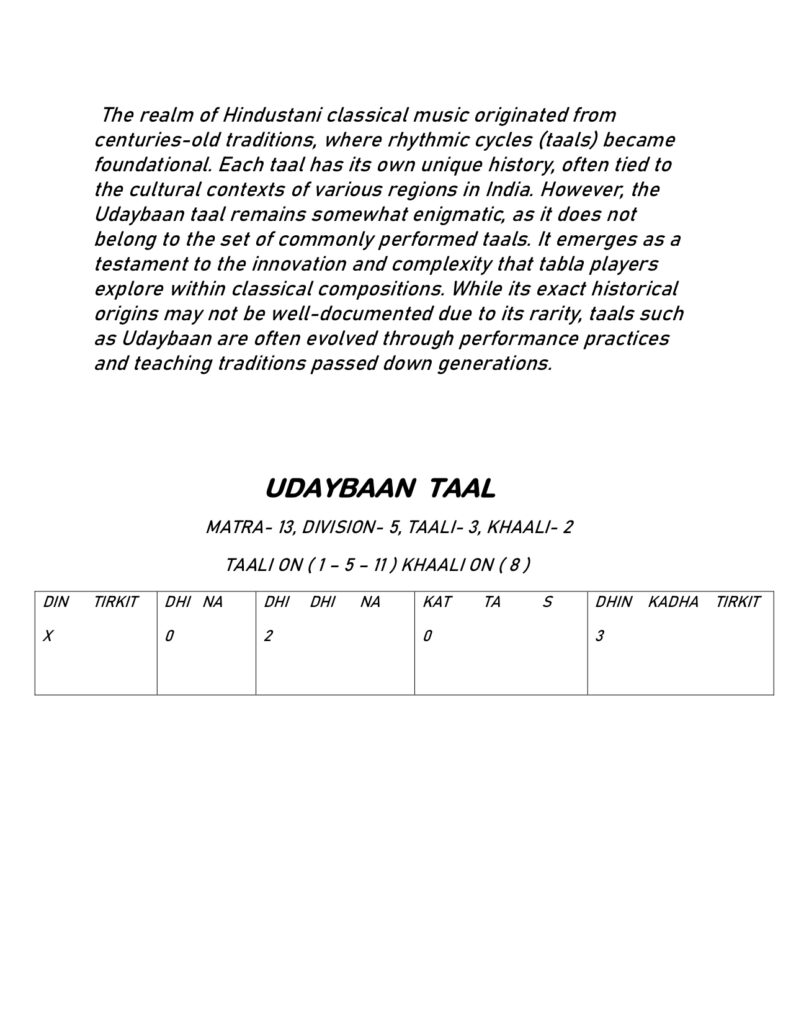Udaybaan taal Theka, Matra-13, The Udaybaan taal exemplifies the rich tapestry of rhythmic cycles in Indian classical music. It’s a testament to the depth and sophistication available to artists who seek to expand their auditory horizons. For those intrigued by rhythms that transcend conventional boundaries, Udaybaan offers an extraordinary challenge as well as a rare auditory experience. The tabla, as an instrument, becomes not merely a rhythmic backdrop but a lead voice in the concert of classical compositions. Exploring lesser-known taals like Udaybaan encourages musicians and listeners alike to embrace the diversity and complexity that Indian classical music has offered for centuries, making it a continuously evolving art form. Whether you are a budding tabla enthusiast or a seasoned aficionado, the Udaybaan taal invites you on a journey through the captivating world of rhythm.
Introducing the-

https://www.youtube.com/@BhagawanSingh
Exploring the Udaybaan Taal: A Rhythmic Marvel in Indian Classical Music
In the vast ocean of Indian classical music, the tabla stands as a remarkable source of rhythmic beauty, complementing the melodic richness of instruments and voice. Among the lesser-known yet intriguing taals used on the tabla is the Udaybaan taal. Let’s delve into the historical context, structural breakdown, and the unique charm of this 13-beat rhythmic cycle.
Historical Context of Udaybaan Taal
The realm of Hindustani classical music originated from centuries-old traditions, where rhythmic cycles (taals) became foundational. Each taal has its own unique history, often tied to the cultural contexts of various regions in India. However, the Udaybaan taal remains somewhat enigmatic, as it does not belong to the set of commonly performed taals. It emerges as a testament to the innovation and complexity that tabla players explore within classical compositions. While its exact historical origins may not be well-documented due to its rarity, taals such as Udaybaan are often evolved through performance practices and teaching traditions passed down generations.
Structural Overview of Udaybaan Taal
- Matra (Beats): 13
- Divisions (Vibhag): 5
- Taali (Claps): 3 occurring on beats 1, 5, and 11
- Khaali (Wave): 2 occurring on beat 8
Udaybaan Taal Structure:
- 1 (Taali)
- 2
- 3
- 4
- 5 (Taali)
- 6
- 7
- 8 (Khaali)
- 9
- 10
- 11 (Taali)
- 12
- 13
The structuring of Udaybaan adds a unique rhythmic cadence that challenges both the tabla player and the accompanying artist to keep perfect time, enhancing the expressivity of the performance.
Unique Features and Characteristics
Udaybaan’s mystique lies in its asymmetrical pattern, which offers artists an opportunity to explore and display intricate variations and improvisations. Unlike more symmetrical taals, Udaybaan provides a challenging platform for creative freedom and rhythmic modulation. The placement of taali and khaali contributes significantly to the distinctive feel, requiring precision from performers to maintain the intended rhythmic flow and balance.
Popular Songs Featuring Udaybaan Taal
While it may not feature as prominently in mainstream or popular compositions due to its complexity, Udaybaan is sometimes explored in classical tabla solos and experimental fusion music. Its presence requires seasoned artists who can gracefully handle its intricacies. As it stands, specific popular songs featuring Udaybaan are not widely recognized, but it serves as a formidable vehicle for solo tabla performances where virtuosity can be showcased.
Conclusion
The Udaybaan taal exemplifies the rich tapestry of rhythmic cycles in Indian classical music. It’s a testament to the depth and sophistication available to artists who seek to expand their auditory horizons. For those intrigued by rhythms that transcend conventional boundaries, Udaybaan offers an extraordinary challenge as well as a rare auditory experience. The tabla, as an instrument, becomes not merely a rhythmic backdrop but a lead voice in the concert of classical compositions.
Exploring lesser-known taals like Udaybaan encourages musicians and listeners alike to embrace the diversity and complexity that Indian classical music has offered for centuries, making it a continuously evolving art form. Whether you are a budding tabla enthusiast or a seasoned aficionado, the Udaybaan taal invites you on a journey through the captivating world of rhythm.
